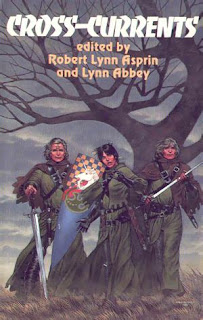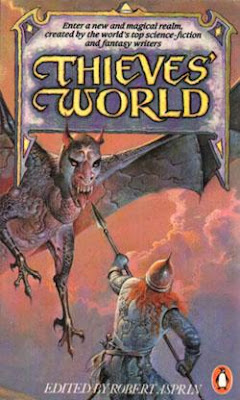All views in this blog are my own and represent the views of no other person, organization, or institution.
For a few years I have been the admin/moderator of the Thieves' World Facebook discussion group. I started a "book club" last year, hoping to spark more discussion about the series. It has been a mixed success. I think in some ways my posts starting the discussion of each anthology have been a bit too big. I also realized, these posts were disappearing into ether after a short short while. In order to give the posts more permanence and so I can more easily refer folks to them, I decided to start putting the "opening" post for each anthology here on my blog.
Now we are on to the fifth anthology, published in 1983.
 |
| The Valdez cover. |
Contents
Introduction by Robert Lynn Asprin
"High Moon" by Janet Morris
"Necromant" by C. J. Cherryh
"The Art of Alliance" by Robert Lynn Asprin
"The Corners of Memory" by Lynn Abbey
"Votary" by David Drake
"Mirror Image" by Diana L. Paxson
All seven of the authors in this volume are Thieves' World veterans, and all of these tales continue stories from previous tales. This marked a shift in the shape of the anthologies, as the over all plot came to dominate the tales and the stories became very connected - it was difficult for a reader to enjoy "The Art of Alliance" if they hadn't read the Cherryh and Morris stories in the previous volumes.
 |
| The Ruddell cover. |
The Valdez cover depicts the three standard warriors outside the Vulgar Unicorn. One is mounted and all appear to be preparing for a trip, fitting given the events of "High Moon" by Janet Morris. The brunnette is less obviously female, unless you look closely at her face. The Ruddell cover is captioned: "A Beysib execution." At least two such executions occur in the anthology, but this doesn't quite look like either. The Beysib executioner's breasts are covered, contrary to textual descriptions but understandably given the realities of the American book market.
 |
| The Pennington cover. |
 |
| Science Fiction Book Club edition |
There was a distinct lack of a Shadowspawn tale in this volume, and based on later comments from Offutt (in The Dead of Winter afterword) the absence was unexpected. There was also a fascinating tonal shift, from Asprin's Introduction where townsfolk are enjoying unexpected prosperity from the arrival of the Beysib to the grim executions and street warfare later in the volume.
You can find this volume in many used book stores online. Also, it is available for Kindle on Amazon here.
An audiobook of this work is available here on Audible.
All views in this blog are my own and represent the views of no other person, organization, or institution.




















.jpg)

.jpg)